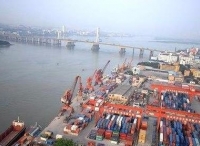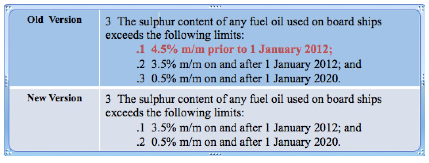最新港口国监督程序 (IMO Resolution A.1119(30))解读
发表于 2018-01-30 16:54
国际海事组织第30次会议通过了关于港口国监督检查程序的A.1119(30) 号决议,它代替了原来的A.1052(27)成为港口国监督检查依据。
对比两个决议,A.1119(30)在程序本身,和附录上做出了许多修改。
IMO Resolution A.1119(30)
滞留一直是船员朋友和船东公司最关注的问题
因此,本期我们将和大家一起了解下,A.1119(30)在附录2滞留指南方面有哪些改变。
壹
Areas under the SOLAS Convention
(属于SOLAS公约范围内可导致滞留的缺陷)
1.Failure of proper operation of propulsion and other essential machinery, as well as electrical installations.
2.Insufficient cleanliness of engine-room, excess amount of oily-water mixture in bilges, insulation of piping including exhaust pipes in engine-room contaminated by oil, and improper operation of bilge pumping arrangements.
3.Failure of the proper operation of emergency generator, lighting, batteries and switches.
4.Failure of proper operation of the main and auxiliary steering gear.
5.Absence, insufficient capacity or serious deterioration of personal life-saving appliances, survival craft and launching and recovery arrangements
(see also MSC.1/Circ.1490/Rev.1).
6.Absence, non-compliance or substantial deterioration to the extent that it cannot comply with its intended use of fire detection system, fire alarms, firefighting equipment, fixed fire-extinguishing installation, ventilation valves, fire dampers, and quick-closing devices.
7.Absence, substantial deterioration or failure of proper operation of the cargo deck area fire protection on tankers.
8.Absence, non-compliance or serious deterioration of lights, shapes or sound signals.
9.Absence or failure of the proper operation of the radio equipment for distress and safety communication.
10.Absence or failure of the proper operation of navigation equipment, taking the relevant provisions of SOLAS regulation V/16.2 into account.
11.Absence of corrected navigational charts, and/or all other relevant nautical publications necessary for the intended voyage, taking into account that electronic charts may be used as a substitute for the charts.
12.Absence of non-sparking exhaust ventilation for cargo pump-rooms.
13.Serious deficiency in the operational requirements listed in appendix 7.
14.Number, composition or certification of crew not corresponding with safe manning document.
15.Non-implementation or failure to carry out the enhanced survey programme in accordance with SOLAS regulation XI-1/2 and the International Code on the Enhanced Programme of Inspections during Surveys of Bulk Carriers and Oil Tankers, 2011 (2011 ESP Code), as amended.
16.Absence or failure of a voyage data recorder (VDR), when its use is compulsory.
新老程序中条款的变化
1第5条
解读:MSC.1/Circ.1490/Rev.1 中详细规定了关于“remotely located survival craft”的救生衣、浸水服、照明设施、登乘梯等一系列配备要求和技术要求。“remotely located survival craft”是指货船上从船首最前端或船尾最末端至最靠近的救生艇筏最近一端的水平距离超过100m的救生艇筏(SOLASregulation III/31.1.4)。
注意:船员在日常维护及检查官在检查过程中应当注意船舶是否满足公约对于“remotely located survival craft”所提出的要求。
2第一标题
解读:《2011年国际散货船和油船检验期间加强检验程序规则》(2011 ESP CODE)于2014年1月1日生效,作为一个强制性规则执行加强检验程序,替代原先的导则A.744(18)。
贰
Areas under the MARPOL Convention, Annex IV
(属于MARPOL附则4公约范围内可导致滞留的缺陷)
最新港口国监督程序中新增MARPOL Convention, Annex IV的内容
解读:新增了关于“缺少有效的ISPP(国际防止生活污水污染)证书”、“污水处理计划未经主管机关认可和证明”、“船员不熟悉排放要求”三项。
A.1052(27)中提出了MARPOL附则IV还在待定过程。
A.1119(30)则正式将生活污水列入了滞留的范畴,说明对船舶在防污染方面的要求被显著提高。
今后,船员和安检员都应加强对此方面的关注。
叁
Areas under the MARPOL Convention, Annex VI
(属于MARPOL附则6公约范围内可导致滞留的缺陷)
1 Absence of valid IAPP Certificate and where relevant EIAPP Certificates and Technical Files.
2 A marine diesel engine, with a power output of more than 130 kW, which is installed on board a ship constructed on or after 1 January 2000, or a marine diesel engine having undergone a major conversion on or after 1 January 2000, which does not comply with the NOx Technical Code 2008.
3 The sulphur content of any fuel oil used on board ships exceeds the following limits:
–.1 3.5% m/m on and after 1 January 2012; and
–.2 0.5% m/m on and after 1 January 2020.
4 The sulphur content of any fuel used on board exceeds 0.1% m/m on and after 1 January 2015 while operating within a SOx emission control area, and respectively, as per provisions of regulation 14.
5 An incinerator installed on board the ship on or after 1 January 2000 does not comply with requirements contained in appendix IV to the Annex, or the standard specifications for shipboard incinerators developed by the Organization (resolution MEPC.244(66)).
6 Ship's personnel are not familiar with essential procedures regarding the operation of air pollution prevention equipment.
7 Absence of valid IEEC (International Energy Efficiency Certificate).
8 Absence of Ship Energy Efficiency Management Plan (SEEMP) not specific for the ship (this may form part of the ship's Safety Management System (SMS)).
新老程序中条款的变化
1第3条
解读:关于船上使用的燃油中硫含量超标而导致滞留,删除了2012年1月1日之前对船上使用的任何燃油的硫含量不应超过4.5%m/m的要求。目前到2020年1月1日止都应满足燃油的硫含量不应超过3.5%m/m的要求。
2第5条
解读:MEPC.76(40)是于MEPC第四十届会议上生效的,该决议提出了关于船用焚烧炉的标准规范,而MEPC.93(45)则是对MEPC.76(40)的一个修订。MEPC.244(66)于2014年4月4日被采纳,用来替代MEPC.76(40)和MEPC.93(45)。
注意:MEPC.76(40)适用于处理能力(capacity)不超过1500KW的船用焚烧炉,而MEPC.244(66)中将适用范围扩大到了处理能力不超过4000KW的船用焚烧炉。
3第7条,第8条(新增条款)
解读:新增“缺少有效IEEC(国际能效证书)”以及“缺少特定的船舶能效管理计划”两条。值得注意的是,其中第八条可能是船舶体系的一部分。
最新港口国监督程序进一步完善了船舶滞留指南,对船舶(特别是防污染方面)提出了更高的要求,望船员朋友和船东公司引起注意、加强日常监督管理!







 联系我们人工客服
联系我们人工客服



















 :1391995811
:1391995811


评论 (0人参与)